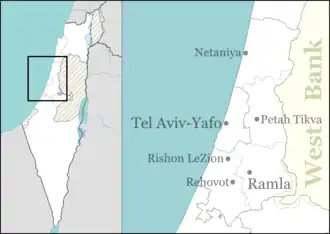Kfar Shmuel
Kfar Shmuel
כְּפַר שְׁמוּאֵל | |
|---|---|
 | |
 Kfar Shmuel | |
| Coordinates: 31°53′22″N 34°55′54″E / 31.88944°N 34.93167°E | |
| Country | |
| District | Central |
| Council | Gezer |
| Affiliation | HaOved HaTzioni |
| Founded | 4 January 1950 |
| Founded by | Romanian-Jewish immigrants |
| Population (2023)[1] | 953 |
Kfar Shmuel (Hebrew: כְּפַר שְׁמוּאֵל, lit. 'Shmuel Village') is a moshav in central Israel. Located in the Shephelah around six kilometres south of Ramle, it falls under the jurisdiction of Gezer Regional Council. In 2023 it had a population of 953.[1]
History
Ancient
Nearby sites such as Tel Gezer and Ekron were major urban centres during the Canaanite and Philistine periods.[2][3] Archaeological evidence from the broader region suggests widespread rural settlement, with remains of wine presses, cisterns and agricultural terraces dating back to the Iron Age, reflecting a strong Israelite presence during the period of the First Temple (c. 10th–6th centuries BCE).[4][5][6]
Modern
The moshav was founded on 4 January 1950 by immigrants from Romania on the land that had belonged to the depopulated Palestinian village of Innaba,[7] which was occupied by Israeli forces on 10 July 1948. It was named after Stephen Samuel (Shmuel) Wise, an American Reform rabbi and Zionist leader.
See also
References
- ^ a b "Regional Statistics". Israel Central Bureau of Statistics. Retrieved 11 August 2025.
- ^ William G. Dever, Recent Archaeological Discoveries and Biblical Research, University of Washington Press, 1990.
- ^ Seymour Gitin, "Ekron of the Philistines: Part I," Biblical Archaeology Review, vol. 16, no. 1, 1990, pp. 26–36.
- ^ Israel Finkelstein and Nadav Na'aman (eds.), From Nomadism to Monarchy: Archaeological and Historical Aspects of Early Israel, Israel Exploration Society, 1994.
- ^ Avraham Faust, Israel’s Ethnogenesis: Settlement, Interaction, Expansion and Resistance, Equinox Publishing, 2006.
- ^ Ze’ev Herzog, "Archaeology of the Shephelah," in: Ephraim Stern (ed.), The New Encyclopedia of Archaeological Excavations in the Holy Land, vol. 4, Israel Exploration Society, 1993.
- ^ Khalidi, Walid (1992). All That Remains: The Palestinian Villages Occupied and Depopulated by Israel in 1948. Washington D.C.: Institute for Palestine Studies. p. 384. ISBN 0-88728-224-5.